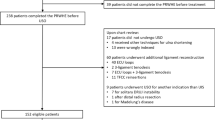Abstract
Introduction
Optimal treatment of chronic distal radioulnar joint (DRUJ) arthritis and instability remains unresolved in the literature. Specifically, no systematic comparison of two common options, Sauve-Kapandji (SK) and Darrach's, is available.
Methods
A meta-analysis was performed utilizing the PUBMED and EMBASE databases and yielded a total of 47 available studies. Objective outcomes, such as wrist range of motion (ROM), forearm ROM, grip strength, and subjective outcomes, including pain and rate of return to work, were recorded. Statistical analysis was done using t test and chi-square test.
Results
For both the SK and Darrach’s procedures, forearm ROM was significantly better postoperatively in both pronation (p = 0.0001 for both groups) and supination (p = 0.0001 for both groups). Wrist flexion decreased in the SK group (p = 0.0007), but no difference was found for wrist extension (p = 0.09). The Darrach's group showed a significance improvement in wrist extension (p = 0.0001). Grip strength was improved in the SK group (p < 0.0001), but not in the Darrach's group (p = 0.7831). No difference existed between the SK and Darrach's groups in proportion of patients who were pain-free. The SK group had higher numbers of patients return to work (p = 0.0057). There was not enough data from the studies to make any meaningful analysis in term of treatment failure and complications.
Conclusions
Overall, both the SK and Darrach's procedures helped improve pain, wrist ROM, and forearm ROM in patient with chronic DRUJ disorders. The SK procedure can have advantages over the Darrach's procedures in terms of grip strength and rate of return to work.

Similar content being viewed by others
References
Chidgey, L. K. (1995). The distal radioulnar joint: Problems and solutions. Journal of American Academy of Orthopaedic Surgeons, 3(2), 95–109. https://doi.org/10.5435/00124635-199503000-00005
Jochen-Frederick, H., Pouyan, Y., Khosrow, B. A., et al. (2016). Long-term functional outcome and patient satisfaction after ulnar head resection. Journal of Plastic, Reconstructive & Aesthetic Surgery, 69(10), 1417–1423.
Darrach, W. (1992). Partial excision of lower shaft of ulna for deformity following colles’s fracture. 1913. Clinical Orthopaedics and Related Research, 275, 3–4.
Carl, H. M., & Lifchez, S. D. (2019). Functional and radiographic outcomes of the sauvé-kapandji and darrach procedures in rheumatoid arthritis. Journal of Hand and Microsurgery, 11(2), 71–79. https://doi.org/10.1055/s-0038-1670926
Minami, A., Iwasaki, N., Ishikawa, J., Suenaga, N., Yasuda, K., & Kato, H. (2005). Treatments of osteoarthritis of the distal radioulnar joint: Long-term results of three procedures. Hand Surgery, 10(2–3), 243–248.
Ikeda, M., Kawabata, A., Suzuki, K., Toyama, M., & Egi, T. (2018). Outcome of the sauvé-kapandji procedure for distal radioulnar joint disorder with rheumatoid arthritis or osteoarthritis: Results of one-year follow-up. Modern Rheumatology, 28(3), 490–494. https://doi.org/10.1080/14397595.2017.1366005
Kawabata, A., Egi, T., Hashimoto, H., Masada, K., & Saito, S. (2010). A comparative study of the modified sauvé-kapandji procedure for rheumatoid wrist with and without stabilization of the proximal ulnar stump. Journal of Hand Surgery (European Volume), 35(8), 659–663. https://doi.org/10.1177/1753193410367599
Minami, A., Kamiya, Y., Tojo, Y., Harmon, S. M., & Suda, K. (2018). Modified sauvé-kapandji procedure for the distal radioulnar joint disorders of osteoarthritis and rheumatoid arthritis. Journal of Orthopaedic Science, 23(3), 516–520.
Giberson-Chen, C. C., Leland, H. A., Benavent, K. A., Harper, C. M., Earp, B. E., & Rozental, T. D. (2020). Functional outcomes after sauve-kapandji arthrodesis. Journal of Hand Surgery (American Volume), 45(5), 408–416.
Abe, A., & IshikawaKim, H. (2019). Ulnar stump stabilization using the flexor carpi ulnaris tendon for the rheumatoid wrist. The Journal of Hand Surgery (Asian-Pacific Volume), 24(4), 447–451. https://doi.org/10.1142/S2424835519500577
Nakagawa, N., Abe, S., Kimura, H., Imura, S., Nishibayashi, Y., & Yoshiya, S. (2003). Comparison of the sauvé-kapandji procedure and the darrach procedure for the treatment of rheumatoid wrists. Modern Rheumatology, 13(3), 239–242. https://doi.org/10.3109/s10165-003-0229-6
Shearman, C. P. (1988). The long-term outcome following darrach’s procedure for complications of fractures of the distal radius. Injury, 19(5), 318–320.
Grawe, B., Heincelman, C., & Stern, P. (2012). Functional results of the darrach procedure: A long-term outcome study. Journal of Hand Surgery (American Volume), 37(12), 2475–2482.
McKee, M. D., & Richards, R. R. (1996). Dynamic radio-ulnar convergence after the darrach procedure. Journal of Bone and Joint Surgery. British Volume, 78(3), 413–418.
Kobayashi, A., Futami, T., Tadano, I., Fujita, M., Watanabe, T., & Moriguchi, T. (2005). Radiographic comparative evaluation of the sauve-kapandji procedure and the darrach procedure for rheumatoid wrist reconstruction. Modern Rheumatology, 15(3), 187–190. https://doi.org/10.1007/s10165-005-0396-8
Ota, N., Nakamura, T., Iwamoto, T., Sato, K., & Toyama, Y. (2013). Radiographic parameter analysis on modified sauvé-kapandji procedure. Journal of Wrist Surgery, 2(1), 19–26. https://doi.org/10.1055/s-0032-1333061
Author information
Authors and Affiliations
Corresponding author
Ethics declarations
Conflict of interest
The authors received no funding for this study and report no conflicts of interest.
Ethical standard statement
This article does not contain any studies with human or animal subjects performed by the any of the authors.
Informed consent
For this type of study informed consent is not required.
Additional information
Publisher's Note
Springer Nature remains neutral with regard to jurisdictional claims in published maps and institutional affiliations.
Supplementary Information
Below is the link to the electronic supplementary material.
Rights and permissions
Springer Nature or its licensor (e.g. a society or other partner) holds exclusive rights to this article under a publishing agreement with the author(s) or other rightsholder(s); author self-archiving of the accepted manuscript version of this article is solely governed by the terms of such publishing agreement and applicable law.
About this article
Cite this article
Nguyen, M.H., Lipari, N., O’Brien, A.L. et al. Darrach vs. Sauve-Kapandji: A Comprehensive Meta-Analysis of Surgical Outcomes in Distal Radioulnar Joint (DRUJ) Dysfunction. JOIO 57, 565–570 (2023). https://doi.org/10.1007/s43465-023-00826-5
Received:
Accepted:
Published:
Issue Date:
DOI: https://doi.org/10.1007/s43465-023-00826-5




